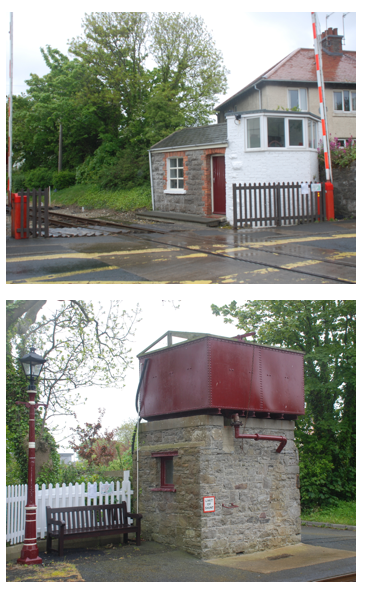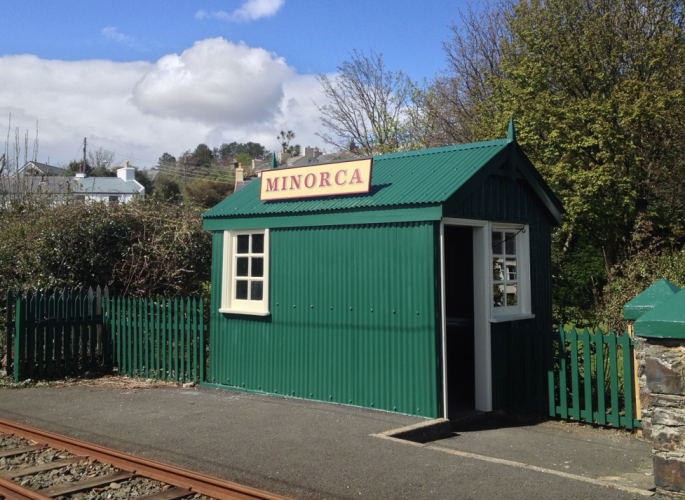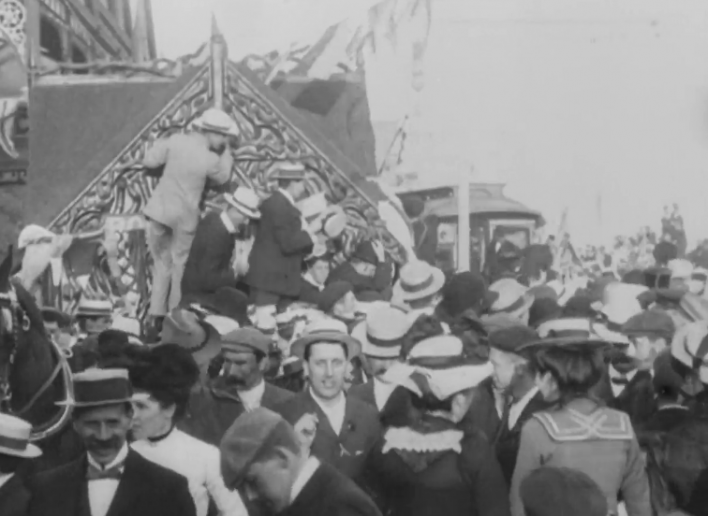Following news that the Island's Steam Railway Supporters have recommended the registration of a further five buildings on the steam railway, should attention turn to listing some of the equally historic structures still left on the Electric line? Indeed, perhaps now is time to bring back the Conservation Policy - proposed by the MERS and endorsed by David Cretney MLC - especially in the light of proposed changes in the Island's Planning regime, and the likely revision of the associated 2007 Strategic Plan...
The buildings for listing which are being proposed by the IoM Steam Railway Supporters' Association (proposals which are to be applauded) are:-
- Port St. Mary Railway Station (Main Building)
- Port St. Mary Goods Shed
- Gate Keepers' Hut, Castletown Road, Port St. Mary (Four Roads).
- The Gate House, Ballasalla Railway Station
- Water Tower, Ballasalla Railway Station
These join six IMR railway buildings already registered, three of which were originally proposed by the steam supporters. They are Santon Station, Colby Level Gatehouse and Ballagawne Gatehouse (which received their Registration in 2014), Port Soderick and Castletown Railway Stations (Registered in 2000 and 2008 respectively), and Douglas Railway Station, together with the Ticket Office, Gateway and boundary walls (Registered back in 1984).
In theory, special consent is required for alterations to a Registered Building - either internally or externally and the owners of a Registered Building are required to maintain it in good condition. Indeed it is a criminal offence to carry out work on a Registered Building without Registered Building Consent.
Cynics may well question the value of such listing, given the recent decision to dramatically alter the interior of Douglas Steam Railway Station, purportedly to fund (in part) the shockingly poor state of repair it had been allowed to fall into by its owners, the Isle of Man Government...
As far as the MER is concerned, the former Ballaglass Power Station (now privately owned) appeared on the Register in 1989, but few if any other structures on the MER are afforded this status.
Whilst edifices such as Douglas and Castletown stations and the Ornamental Gateway on the Marine Drive (Registered in 2006) are substantial stone creations, the 'listed' Santon Station is basically a wooden shed with a corrugated iron roof, as are most buildings on the MER. Therefore if Santon station can be listed, then why not structures such as Derby Castle Ticket Office (one of the last remaining Isle of Man Tramway & Electric Power Company structure see below), Laxey Station, Laxey Goods shed, and modest buildings such as those at Baldrine, Minorca, integral to the ambience and character of the railway? Even the substantial Ramsey Car Shed? But with the proposed Ramsey Plaza Transport Interchange now back on the agenda, the chances of the latter surviving as far as Christmas are slim.

This appetite for listing comes at a time when planning on the Island is undergoing a shakeup, as what gets built where is set to be used as a weapon to address the VAT shortfall and what appears to be a steady decline in the once bouyant finance sector. The changes to the planing regime also come at a time amidst opposition to some of the so called 'regeneration schemes', a growing campaign against proposals to remodel Douglas Promenade and its implications for the horse tramway, and a feeling abroad that these and other proposals may be 'steamrollered' through irrespective of the the sensibilities of the public, unpopular developments 'justified' by economic imperatives.
"We need to wake up, smell the coffee" said the Chief Minister in Keys in April when commenting on recent planning decisions which had in his opinion got in the way of the Island "attracting new business to our shores". "If we do not wake up, Mr Speaker, the Isle of Man is going to have a very difficult future."
Be that as it may, perhaps one of the first results of the new approach to planning will be the MER station in Ramsey.
The Ramsey Plaza Transport Interchange was refused by the Planning Inspector back in February (a decision endorsed at the time by the Council of Ministers). In the opinion of the Planning Inspector "the character and appearance of the [proposed bus maintenance] yard, including its unrelieved concrete surfacing and the parked buses and plant and equipment within it, this would produce an inappropriate visual context for the Railway, which would detract from its enjoyment by passengers and from the attractiveness of Ramsey town centre as a destination for tourists and other visitors."
The Planing Inspector noted that the plans submitted by the DoI "would be contrary to Transport Policy 3 of the Isle of Man Strategic Plan, which includes provisions that new development should not compromise the attraction of rail routes as tourism and leisure facilities. or their potential as public transport routes."
The Island's Chief Minister admitted in Keys in April that he is not a fan of the 2007 Strategic Plan: "I think the Island Strategic Plan has been one of the biggest mistakes this Government has made in the last few years. We have lost a lot of business investment and also frustration for our own community because of it."
Speaking on Manx Radio last week, Treasury Minister Eddie Teare, sees schemes such as that in Ramsey as a way of addressing the current level of unemployment in the construction industry. "One of the big schemes which we had, actually fell at the planning process and that was the Ramsey interchange for the bus and the Manx Electric Railway. If that had of gone through that's would've created extra employment in the construction industry. We're currently working on reconfiguring that, and I'm hoping that a new planning application will be submitted shortly, and will be successful and that will enable us to break a log jam there."
Whilst Registration of MER buildings is an option, perhaps what is really needed is a return to the 'Conservation Policy' brokered by the MERS with then Minister, Mr David Cretney. As well as buildings, the Policy embraced rolling stock and other artifacts and could be extended to cover many other things that make the railways of the Isle of Man unique, and so appealing.
In the light of the above surely now is the time for it to be resurrected, not simply to avoid 'change' at the expense of 'jobs', but to enhance the economic appeal of the railways, their ability to continue to attract visitors from UK and far beyond, now and into the distant future and so contribute to employment and the economy.
Rather than short-term, piecemeal ill-conceived tinkering, with old stations lit by LEDs and vintage tramcars crewed by hi-vis staff, we should be looking at creating 'World Heritage" status for our transport attractions, through a policy - whether it be planning or economic - a vision that lays down guidelines for investment and development towards this end.
Derby Castle Boooking Office, here as King Edward VII is driven past the cheering crowds, in 1902. This survivor from a bygone age may soon, like the King and the crowds surrounding it, be consigned to history.
Since publication of the article, the following comments have been posted on the MERS Facebook page.
"We have a weak Minister who is reluctant to take decisions... This is the correct decision but he has failed to do anything to prevent the destruction of the tramway and its infrastructure. He appears to belong (despite his remarkable antecedents) to the Manx Political Class... There can therefore be little confidence that he will act like any other Manx politician (saving of course Sor Charles Kerruish and Mr Cretney)..."
MERS would like to hear your views. If you have any comments or further information on this story, please email the Manx Electric Railway Society at [email protected]


